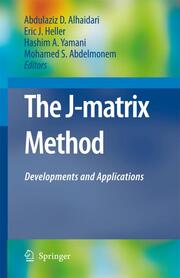-
Zusatztext
-
Although introduced30 years ago, the J-matrix method has witnessed a resurgence of interest in the last few years. In fact, the interest never ceased, as some authors have found in this method an effective way of handling the continuous spectrum of scattering operators, in addition to other operators. The motivation behind the introduction of the J-matrix method will be presented in brief. The introduction of fast computing machines enabled theorists to perform cal- lations, although approximate, in a conveniently short period of time. This made it possible to study varied scenarios and models, and the effects that different possible parameters have on the ?nal results of such calculations. The ?rst area of research that bene?ted from this opportunity was the structural calculation of atomic and nuclear systems. The Hamiltonian element of the system was set up as a matrix in a convenient, ?nite, bound-state-like basis. A matrix of larger size resulted in a better con?guration interaction matrix that was subsequently diagonalized. The discrete energy eigenvalues thus obtained approximated the spectrum of the system, while the eigenfunctions approximated the wave function of the resulting discrete state. Structural theorists were delighted because they were able to obtain very accurate values for the lowest energy states of interest.
-
-
Kurztext
-
This volume aims to provide the fundamental knowledge to appreciate the advantages of the J-matrix method and to encourage its use and further development. The J-matrix method is an algebraic method of quantum scattering with substantial success in atomic and nuclear physics. The accuracy and convergence property of the method compares favourably with other successful scattering calculation methods. Despite its thirty-year long history new applications are being found for the J-matrix method. This book gives a brief account of the recent developments and some selected applications of the method in atomic and nuclear physics. New findings are reported in which experimental results are compared to theoretical calculations. Modifications, improvements and extensions of the method are discussed using the language of the J-matrix. The volume starts with a Foreword by the two co-founders of the method, E.J. Heller and H.A. Yamani and it contains contributions from 24 prominent international researchers.
-
-
Autorenportrait
- InhaltsangabeForeword 1: Two of the Original Papers. 1.1. New L2 approach to quantum scattering: Theory; E.J. Heller and H.A. Yamani. 1.2. J-matrix method: Extensions to arbitrary angular momentum and to Coulomb scattering; H.A. Yamani and L. Fishman. 2: Theoretical and Mathematical Considerations. 2.1: Oscillator basis in the J-matrix method: convergence of expansions, asymptotic of expansion coefficients and boundary conditions; S.Yu. Igashov. 2.2. Scattering phase shift for relativistic separable potential with Laguerre-type form factors; A.D. Alhaidari. 2.3. Accurate evaluation of the S-matrix for multi-channel analytic and non-analytic poetentials in complex L2 bases; H.A. Yamani and M.S. Abdelmonem. 2.4. J-matrix and isolated states; A.M. Shirokov and S.A. Zaytsev. 2.5. On the regularization in J-matrix methods; J. Broeckhove, V.S. Vasilevsky, F. Arickx and A.M. Sythcheva. 3: Applications in Atomic Physics. 3.1. The J-matrix method: a universial approach for the description of the process of ionization of atoms; V.A. Knyr, V.V. Nasyrov, Yu.V. Popov and S.A. Zaytsev. 3.2. Coulomb-Sturmian separable expansion approach to the Faddeev-type integral equations of the three-body Coulomb problem; Z. Papp. 3.3. The use of complex scaling method to calculate resonance partial widths; H.A. Yamani and M.S. Abdelmonem. 4: Applications in Nuclear Physics. 4.1. J-matrix approach to loosely-bound three-body nuclear systems; Yu.A. Lurie and A.M. Shirokov. 4.2. Nucleon-nucleon interaction in the J-matrix inverse scattering approach and few-nucleon systems; A.M. Shirokov, S.A. Zaytsev, A.I. Mazur, J.P. Vary and T.A. Weber. 4.3. The modified J-matrix approach for cluster descriptions of light nuclei; F. Arickx, J. Broeckhove, A. Nesterov, V. Vasilevsky and W. Vanroose. 5: Other Related Methods: Chemical Physics Application. 5.1. A generalized formulation of density functional theory with auxiliary basis sets; B.G. Johnson and D.A. Holder
Detailansicht
The J-matrix Method
Recent Developments and Selected Applications
ISBN/EAN: 9781402060724
Umbreit-Nr.: 1613118
Sprache:
Englisch
Umfang: xviii, 356 S.
Format in cm:
Einband:
gebundenes Buch
Erschienen am 01.04.2008
Auflage: 1/2008


